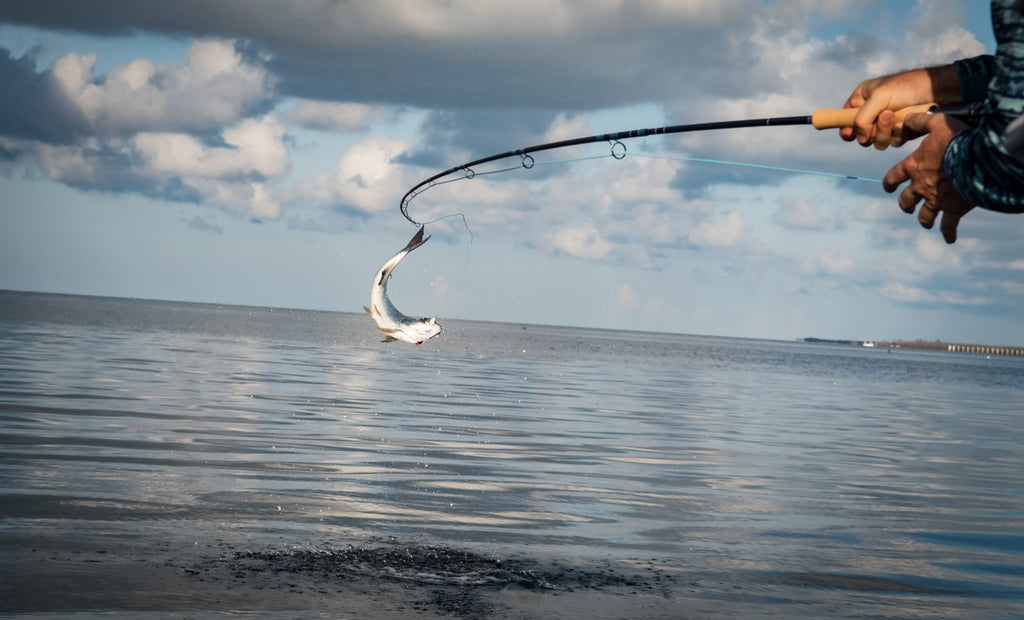Anglers from all around the country and the world venture to the Southeastern United States to experience fly fishing for a myriad of marine species in the Gulf of Mexico and South Atlantic coast. From Virginia down to northern Florida, anglers have access to an incredible salt marsh system with a vast network of tidal creeks, oyster and sand bars, mud flats, and spartina grass flats. And just a day trip away is the world-class fishery of Louisiana and the Mississippi Gulf Coast for bull redfish, black drum, jacks, and the occasional tarpon. And no conversation about the fishery that comprises the Southeastern U.S. is nearly complete until you bring in the state of Florida. From Gulf Shores, Alabama down through 30A, Apalachicola, Homosassa, the Everglades and finally to the southernmost point at the corner of South St. in Key West is a fishery in a class of its own where the angling history is rich.
No where else on this planet can you find trophy-sized tarpon, bonefish, permit, snook, redfish, black drum, cobia, jacks, sheepshead, and tripletail in such close proximity to each other. That is why it is so important for us as anglers to protect it and be good stewards to the land and water that comprise this diverse fishery. There is no place like it - we are incredibly fortunate to have this in our backyard.
At Thomas & Thomas, our job has always been simple - continue to enhance, develop, and craft exceptional handmade fly rods to exceed the expectations of fly anglers. We’re privileged to lean on the expertise of some of the top guides in the Southeastern U.S. to help us continually do our job better. Recently, we were able to ask a few of these individuals their thoughts on what fly rods they use on the water for different fishing situations. Read below to find out more about what Thomas & Thomas fly rods the pros use to fish the salt waters of the Southeastern U.S.

What is your go-to fly rod(s) for the species you target?
Capt. Dale Perez: We use the Exocett 11-weight for tarpon, Exocett 10-weight for permit and either a 8 or 9-weight Exocett for bonefish, redfish, and snook depending on the wind.
Capt. Al Keller: I prefer to use the Exocett 10-weight for fly fishing for tarpon in the Ten Thousand Islands and Everglades area as well as for redfish in Louisiana.
Capt. Justin Rea: My go-to rod right now is the Exocett SS 350 for most species. I have been using these rods for permit, tarpon, bonefish and snook. I also carry a couple other rods in the boat like the Exocett 7 and 8 weights with Hatch 7-plus reel and Scientific Anglers Infinity salt lines for light wind presentations.
What about the features of the rod make it an important tool to have for targeting numerous saltwater species?
Capt. Dale Perez: The Exocett rods are light and are able to load and cast very easy.
Capt. Al Keller: The Exocett allows for quick casts inside of forty feet, where the majority of fish are caught, and the ability to cast and handle large flies.
Capt. Justin Rea: This combo (Exocett SS 350) is so fun to cast. It loads quick and allows me to shoot line to the target lightning fast.

In your opinion, what are a few of the rods’ strengths for fishing in your area?
Capt. Dale Perez: Light and well-balanced! We were fishing for a laid-up tarpon on a calm day and had to cast at least 70 feet. We ended up catching the fish which we estimated at 150 pounds. That day we put the 11-weight Exocett to a real test and it performed flawlessly.
Capt. Al Keller: A few of the Exocett’s strengths that I appreciate is it’s durability, lifting power, and “non-corrosive” rod guides which are important to have in saltwater environments.
Capt. Justin Rea: The ability to load quick and the lifting power! I have even maxed the Exocett SS 350 on fish over 100lbs.

What reel/fly line do you pair with your Thomas & Thomas fly rod?
Capt. Dale Perez: For tarpon I use Nautilus Silver King and Monster fly reels, for permit I use a Nautilus NV 10/11, and for bonefish/snook/redfish I use a Nautilus NV 8/9. They all have weight-forward floating fly lines from RIO.
Capt. Al Keller: I use Abel reels and any weight-forward floating fly line.
Capt Justin Rea: I match it with a Hatch 11 plus and a Scientific Angler Amplitude Infinity Salt 11-weight fly line which is 355 grains. 
What type of casts should I work on before visiting your fishery?
Capt. Dale Perez: You need to be able to make accurate casts that average forty feet in normal conditions. On calm days, anglers need to be able to make accurate casts of at least sixty feet.
Capt. Al Keller: Anglers should work on making up to forty-foot traditional casts that are accurate for sight fishing.
Capt. Justin Rea: If you plan on fishing the Florida Keys you should work on a short stroke and quickly shoot the fly line to the target. Do not false cast more than two times! Shoot the fly line out of the rod like you’re trying to overshoot your target and then stop the line with your off hand at the target. Always shoot line on your forward and back casts.
